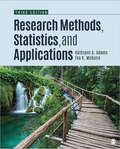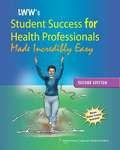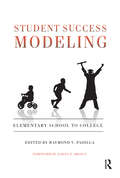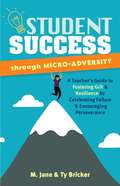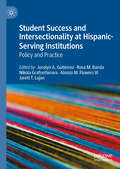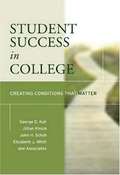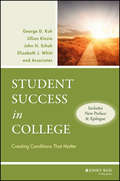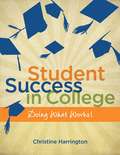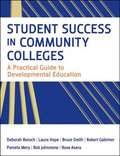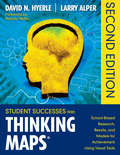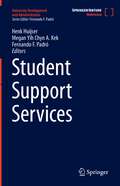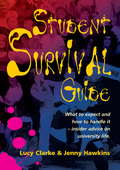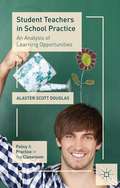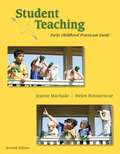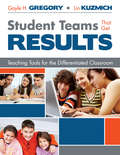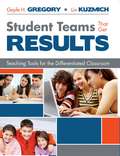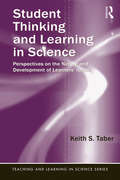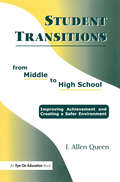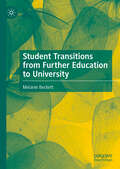- Table View
- List View
Student Study Guide With IBM® SPSS® Workbook for Research Methods, Statistics, and Applications
by Kathrynn A. Adams Eva Kung McGuire (aka: Lawrence)The third edition of the Student Study Guide With IBM® SPSS® Workbook for Research Methods, Statistics, and Applications by Kathrynn A. Adams and Eva K. McGuire gives students even more opportunities to practice and apply their knowledge in statistics and research methods. Written by the authors of Research Methods, Statistics, and Applications, the third edition of the study guide follows the third edition of the textbook for straightforward assigning and practice. New features include practice quizzes to give students both recognition and recall activities for better retention. Learning objectives and brief chapter summaries from the main text remind students of what they′ve learned and orient students toward the exercises. In-depth exercises encourage students to build on their knowledge, requiring students to think critically and actively engage with the material. These exercises have been condensed and focus on moving students through the learning objectives at a quick pace. At the end of most chapters, "Your Research" sections encourage students to apply concepts to their own projects. Now placed at the end of book, the IBM® SPSS® workbook provides instructions for performing statistical calculations. Included in this workbook are additional exercises to practice data analysis and interpretation using the software. Answers to quizzes are listed immediately after each quiz in the book while answers to exercises are listed on the instructor resources website.
Student Study Guide With IBM® SPSS® Workbook for Research Methods, Statistics, and Applications
by Kathrynn A. Adams Eva Kung McGuire (aka: Lawrence)The third edition of the Student Study Guide With IBM® SPSS® Workbook for Research Methods, Statistics, and Applications by Kathrynn A. Adams and Eva K. McGuire gives students even more opportunities to practice and apply their knowledge in statistics and research methods. Written by the authors of Research Methods, Statistics, and Applications, the third edition of the study guide follows the third edition of the textbook for straightforward assigning and practice. New features include practice quizzes to give students both recognition and recall activities for better retention. Learning objectives and brief chapter summaries from the main text remind students of what they′ve learned and orient students toward the exercises. In-depth exercises encourage students to build on their knowledge, requiring students to think critically and actively engage with the material. These exercises have been condensed and focus on moving students through the learning objectives at a quick pace. At the end of most chapters, "Your Research" sections encourage students to apply concepts to their own projects. Now placed at the end of book, the IBM® SPSS® workbook provides instructions for performing statistical calculations. Included in this workbook are additional exercises to practice data analysis and interpretation using the software. Answers to quizzes are listed immediately after each quiz in the book while answers to exercises are listed on the instructor resources website.
Student Success For Health Professionals
by Lippincott Williams Wilkins Staff Nancy OlrechThis Second Edition of Lippincott Williams & Wilkins' Student Success for Health Professionals Made Incredibly Easy has been revised and updated with a more user-friendly organization and design, but retains the health professions focus, the concise and approachable narrative, the fun features and art, and the self-paced online course of the first edition. It is still the first and only student success text designed specifically for health professions students and programs!
Student Success Modeling: Elementary School to College
by Raymond V. PadillaThis book focuses on one of the key questions in education: What determines a student’s success?Based on twenty years of work on student success, Ray Padilla here presents two related models he has developed that both provide a framework for understanding success and indicate how it can be enhanced and replicated. The research and theory that inform his models are covered in detail.He defines student success simply as progress through a program of study, such that the student and others expect him or her to complete it and be promoted to the next level or graduate. Rather than focusing on the reasons for failure or drop out, his approach focuses on understanding the factors that account for student success and that enable many students, some of them under the most challenging circumstances, to complete all program requirements and graduate. The models provide schools and colleges with an analytical tool to uncover the reasons for student success so that they can develop strategies and practices that will enable more students to emulate their successful peers. They address the characteristics of the students—such as motivation and engagement, the ability to surmount barriers, and persistence—and similarly surface the characteristics of teachers, the educational institution, its resources, and the contexts in which they interact. The process provides administrators with a clear and appropriate strategy for action at the level of each individual unit or subpopulation. Recognizing the need to develop general models of student success that also can be applied locally to specific situations and contexts, the book presents Padilla’s Expertise Model of Student Success (EMSS) that can be applied to general populations, as well as the Local Student Success Model (LSSM) that can be used to drive local institutional strategies to improve student success.The book demonstrates how the models have been applied in settings as diverse as a minority high school, a community college, and an Hispanic Serving Institution, and for such purposes as comparing a high-performing and a non high-performing elementary school. Contributors:* Kimberly S. Barker is an assistant professor at Texas A&M University-Kingsville, System Center San Antonio. She is currently working in the College of Education, Department of Curriculum and Instruction.* Mary J. Miller is the Instructional Compliance Director for the Edgewood Independent School District in San Antonio, Texas. Prior to this appointment, she served as an elementary school principal for ten years.* George E. Norton is the Assistant Vice President of Student Affairs for Admissions, Orientation & Transition Services at The University of Texas at San Antonio.* Ralph Mario Wirth is an administrator and director of educational planning at The San Antonio School for Inquiry and Creativity, as well as lead researcher for the Democratic Schools Research Institute, Inc.
Student Success Through Micro-Adversity: A Teacher's Guide to Fostering Grit and Resilience by Celebrating Failure and Encouraging Perseverance (Books For Teachers Ser.)
by M. Jane Ty BrickerCultivate resilience by incorporating small challenges (also known as micro-adversities) in your classroom with effective, trauma-informed strategies that are proven to improve behavior, increase engagement, and empower students to achieve.One in four children have witnessed or experienced a traumatic event by the age of 16 that can affect behavior and learning. Fortunately, educators of all grade levels can inspire resilience and grit that helps students adapt to change and overcome hardship with simple everyday activities. This book offers a breakthrough method for building community and empowering your students with a new strategy: micro-adversity. Micro-adversities in the classroom can be actionable activities, like trying to solve a puzzle that is intentionally missing a few pieces, or building emotional intelligence with conversation starters. By experiencing small failures, students learn to overcome them and thrive. Written by two teachers, one a former US Army Ranger, this method combines the extensively trained military perspective with the important foundations of trauma-informed education.
Student Success and Intersectionality at Hispanic-Serving Institutions: Policy and Practice
by Rosa M. Banda Jocelyn A. Gutierrez Nikola Grafnetterova Alonzo M. Flowers III Jarett T. LujanWith the influx of Hispanic-Serving Institutions (HSIs) on the landscape of higher education, it has become apparent that institutional policy, practices, and procedures for student success must be understood from an empirical and practitioner standpoint. This edited book offers current scholar/practitioners the opportunity to evidence empirical-based strategies and practices at HSIs relating to student success.
Student Success in College: Creating Conditions That Matter
by George D. Kuh Jillian Kinzie John H. Schuh Elizabeth J. WhittStudent Success in College describes policies, programs, and practices that a diverse set of institutions have used to enhance student achievement. This book clearly shows the benefits of student learning and educational effectiveness that can be realized when these conditions are present. Based on the Documenting Effective Educational Practice (DEEP) project from the Center for Postsecondary Research at Indiana University, this book provides concrete examples from twenty institutions that other colleges and universities can learn from and adapt to help create a success-oriented campus culture and learning environment.
Student Success in College: Creating Conditions That Matter
by George D. Kuh Jillian Kinzie John H. Schuh Elizabeth J. WhittStudent Success in College describes policies, programs, and practices that a diverse set of institutions have used to enhance student achievement. This book clearly shows the benefits of student learning and educational effectiveness that can be realized when these conditions are present. Based on the Documenting Effective Educational Practice (DEEP) project from the Center for Postsecondary Research at Indiana University, this book provides concrete examples from twenty institutions that other colleges and universities can learn from and adapt to help create a success-oriented campus culture and learning environment.
Student Success in College: Doing What Works!
by Christine HarringtonThis book offers an accessible and relevant way for students to move beyond opinions and advice about how to succeed in college by offering an integrated approach of researched back student success practices paired with student success research studies.
Student Success in Community Colleges
by Laura Hope Pamela M. Mery Rose Asera Bruce M. Smith Deborah J. Boroch Robert S. Gabriner John Nixon Robert M. JohnstoneAs changing demographics bring underprepared students to college, higher education institutions are growing concerned about basic skills education. Student Success in Community Colleges: A Practical Guide to Developmental Education provides a self-assessment instrument, investment modeling tools, and practices to succeed in community college. Compiled with over two-hundred-and-fifty published sources and thirty years of research, this guidebook explores administrative obstacles to learning and shows practical ways for faculty to modify teaching and supportive services for immediate improvement.
Student Successes With Thinking Maps®: School-Based Research, Results, and Models for Achievement Using Visual Tools
by David N. Hyerle Lawrence S. AlperUse Thinking Maps® as a GPS for student success Neuroscientists tell us that the brain organizes information in networks and maps. What better way to teach students to express their ideas than with the same method used by the brain? Student Successes With Thinking Maps presents eight powerful visual models that boost all learners' metacognitive and critical thinking skills. Enriched with new research, a wealth of examples, and cross-content applications, this novel and effective resource helps students: Organize thoughts Examine relationships Enhance reasoning skills Create connections between subjects Engage with content
Student Support Services (University Development and Administration)
by Henk Huijser Megan Yih Chyn A. Kek Fernando F. PadróThis volume Student Support Services: Exploring impact on student engagement, experience and learning, covers a wide and diverse range of higher education contexts to explore the current state and the future of student support services. The central focus for all the chapters is about what, why and how to achieve student success within an intricate and complex web of learning ecologies, often invisible to the naked eye but interconnected within and between each other. This has profound impacts on students, often characterised by an ongoing tension between students as learners and students as consumers. With over 40 chapters, the book is divided into two sections. Part 1 is a conceptual section, which explores a multitude of worldviews about the ways in which student support services have impacted and may impact on student engagement, experience and learning. This includes discussions about the tensions and opportunities that arise from the curricular, co-curricular, and extra-curricular conceptualisations of students support services. The discussions come from the vantage point of different ecologies within and between universities and student support services’ impacts, both intentional and accidental, on the development of students, their transformation as learners and as contributing members of the workforce. For example, this covers disruptive technologies and online approaches, university mission and purpose, worldviews and paradigms held by student support and services units, motivation, student retention, and sense of belonging. Part 2 is a practice-based section with reflections and case studies, again from a wide variety of different higher education contexts. This section dives into the how – approaches, solutions, processes – deployed by universities to respond to their identified and often contextualised student support and services challenges. This section provides a rich library of possible ideas that readers can reimagine to manage and/or solve their student support and services challenges and problems. In the context of widening participation agendas and an increasingly demand-driven higher education sector, combined with ever-tighter public funding streams and turbulent socio-political environments, the higher education sector has had to step up its game in attracting students and diversify its approaches and strategies. As part of recruitment strategies and marketing campaigns, it has become common to approach potential students as ‘customers’. Transaction as a form of two-way (beneficial) engagement has given way to transaction as an exchange for a service or a good focused on order, structure and risk aversion. This book explores whether this is a productive way of approaching it. At the same time, the impact of COVID-19 has drawn further attention to the challenges of creating a sense of community, sense of belonging, personal identity and engagement within the university environment, especially for those not habitually and constantly on-campus. The difficulty of commuter students more fully engaging with university curricular and co-curricular programs remains, especially as students have to spend more of their time working to meet direct and indirect costs of partaking in university studies. Thus, student identity, in terms of being (or becoming) an integral member of the university community, and co-and extra-curricular engagement that enhances the learning of online students are increasingly important areas for universities to pay attention to, and this book shows different pathways – both worldviews and practices - in that respect. In an increasingly complex higher education environment, student support services find themselves in an interesting, yet often contradictory, position of having to provide a ‘customer service’ while also 'developing students’ throughout their learning journeys within the university, and their future readiness beyond the university, which is increasingly pertinent in a supercomplex world of diversity, contradictions and uncertainties. This volume
Student Survival Guide: What To Expect And How To Handle It - Insider Advice On University Life
by Lucy Clarke Jenny HawkinsLucy Clarke and Jenny Hawkins, both current students at Cardiff University, have written this guide to university life encompassing study, the social scene, accommodation and making the best of university. They cover issues from the chaos of Fresher's week and difficult landlords, to sex and social life, the stress of finals and beyond. Recipes and a university dictionary are also included.
Student Survival Guide: What to expect and how to handle it - insider advice on university life
by Lucy Clarke Jenny HawkinsLucy Clarke and Jenny Hawkins, both current students at Cardiff University, have written this guide to university life encompassing study, the social scene, accommodation and making the best of university. They cover issues from the chaos of Fresher's week and difficult landlords, to sex and social life, the stress of finals and beyond. Recipes and a university dictionary are also included.
Student Teachers in School Practice
by Alaster Scott DouglasThis book discusses changes to student teacher education globally and in the UK, exploring how student teachers learn through school teaching practices and ideas for developing and maximizing learning opportunities in school-based student teacher education.
Student Teaching: Early Childhood Practicum Guide (What's New In Early Childhood)
by Jeanne Machado Helen BotnarescueThis comprehensive text presents up-to-date research and how tos for those enrolled in an early childhood student teaching practicum course. It clearly explains a student teacher's professional duties and responsibilities, the mechanics of hands-on teaching under the guidance of a cooperating teacher, and students' interactions with their college course supervisor(s). Chapters are designed to encourage contemplative and reflective thought as students develop an understanding of professionally accepted practice, ethics, classroom management, and individualized and group program planning and instruction. Communication skills that typify effective team teaching and reduce common classroom problems during student teaching are described and detailed. Current practices related to special-needs children and infant-toddler classroom placement are addressed, as is the development of school-home partnerships that enhance children's life-long learning and educational success. Throughout, case studies and examples illustrate real-life situations and children that other student teachers have encountered.
Student Teams That Get Results: Teaching Tools for the Differentiated Classroom
by Gayle H. Gregory Linda M. KuzmichIntegrating effective grouping strategies with research-based practices, this resource provides more than tools that help diverse students work cooperatively and learn together in differentiated classrooms.
Student Teams That Get Results: Teaching Tools for the Differentiated Classroom
by Gayle H. Gregory Lin KuzmichThis resource shows how students who work together and share ideas with one another can deepen their understanding of essential concepts. Combining effective grouping strategies with other research-based practices, this resource focuses on the power of student collaboration and dialogue in differentiated classrooms. Students can strengthen critical thinking and achievement through three key skills: teaming to learn, sharing knowledge and skills, and integrating and applying learning. The authors offer more than 100 reproducible planning tools to help learners: * Improve critical thinking * Generalize and infer * Integrate content and Identify patterns * Increase adaptive and analytical reasoning By utilizing these innovative teaching tools and strategies with their student teams, teachers can prepare all students for deeper thinking and success--both in the classroom and on assessments!
Student Test Preparation Booklet LEVEL M (Fountas & Pinnell LLI Red #Level M)
by Leveled Literacy Intervention RED SystemStudent Test Preparation Booklet LEVEL M LESSONS 61-64
Student Test Preparation Booklet Level N (Fountas & Pinnell LLI Red #Level N)
by Leveled Literacy Intervention RED SystemStudent Test Preparation Booklet LEVEL N LESSONS 93-96
Student Test Preparation Booklet Level O (Fountas & Pinnell LLI Red #Level O)
by Leveled Literacy Intervention RED SystemStudent Test Preparation Booklet LEVEL O LESSONS 125-128
Student Test Preparation Booklet Level P (Fountas & Pinnell LLI Red #Level P)
by Leveled Literacy Intervention RED SystemStudent Test Preparation Booklet LEVEL P LESSONS 157-160
Student Thinking and Learning in Science: Perspectives on the Nature and Development of Learners' Ideas (Teaching and Learning in Science Series)
by Keith S. TaberThis readable and informative survey of key ideas about students’ thinking in science builds a bridge between theory and practice by offering clear accounts from research, and showing how they relate to actual examples of students talking about widely taught science topics. Focused on secondary students and drawing on perspectives found in the international research literature, the goal is not to offer a comprehensive account of the vast literature, but rather to provide an overview of the current state of the field suitable for those who need an understanding of core thinking about learners’ ideas in science, including science education students in teacher preparation and higher degree programs, and classroom teachers, especially those working with middle school, high school, or college level students. Such understanding can inform and enrich science teaching in ways which are more satisfying for teachers, less confusing and frustrating for learners, and so ultimately can lead to both greater scientific literacy and more positive attitudes to science.
Student Transitions From Middle to High School
by J. Allen QueenThis book shows administrators and teachers what they can do to make their students' ninth grade experience a successful one. Practical and research-based, this book showcases strategies to help you reduce your dropout rate, enhance student achievement, and provide a safe environment for your ninth grade students.
Student Transitions from Further Education to University
by Melanie BeckettThis book presents the life stories and lived experiences of 12 individuals who transitioned from the sixth form of a further education college in a traditionally working-class area of the UK, to higher education. The author employs narrative inquiry in order to explore the participants’ unique perspectives. Theoretically, Bourdieu’s concepts of field and habitus are used to explain how these undergraduates adapted to their new circumstances, which in turn altered their ways of thinking and behaving. The book examines the impact of class on student transition, as well as offering insights into why further education warrants renewed focus, and concludes with a set of recommendations for both policy and practice.
